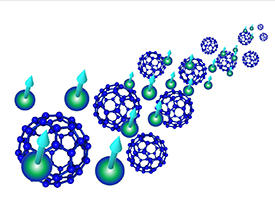

03/25/2013

© 2013 Miyazaki–Mizukami group
An ability to control the spin of the electron would enable the design of spintronic devices that are more efficient than current electronic ones. Research efforts have so far focused on solid-state inorganic materials that can be fabricated to a high purity, easily incorporated into devices and whose composition can be precisely controlled. However, organic materials also pose several advantages, including low processing costs and the opportunity to control their physical properties through careful chemical modification.
Since organic compounds are typically made from light elements — primarily carbon — the spin–orbit interaction, which couples the spin momentum with the angular momentum of the electron, is quite small. This means that the electron spin can be preserved for a long time and electrons can, in principle, travel long distances without flipping their spin. Until recently, the longest distances travelled at room temperature were in the few tens of nanometers and a greater distance had only been observed at a low temperature. Xianmin Zhang and co-workers have now realized devices based on an organic material in which the electrons can travel distances of up to 110 nanometers at room temperature, while preserving their spin1 (see image).
The researchers constructed their devices from films of fullerene (C60), a molecule which has low spin–orbit interactions as it consists solely of carbon atoms. The absence of hydrogen — common in other organic materials — serves to reduce the hyperfine interactions between electron and nuclear spins that can induce spin-flipping events. Zhang and colleagues fabricated organic spin valves, in which two ferromagnetic electrodes are placed in contact with an organic layer, and measured their magnetoresistance, which is the difference in electrical resistance when the spin valve’s electrodes are magnetized in the same or opposite direction. Magnetoresistance is therefore a measure of the conservation of the electron’s spin polarization.
By studying devices composed from various thicknesses of the C60 film, the team observed a record value — of up to 110 nanometers in length — for magnetoresistance at room temperature. Zhang explains that it may be possible to further improve on these results as, according to theory, a spin length of over 400 nanometers can be obtained in crystalline C60 — although fabricating films of such a well-ordered material would be quite challenging.
According to Zhang, the significance of the team’s results is not limited to C60: an understanding of spin transport in these films could inspire chemists and engineers to design even more efficient compounds and devices.
Zhang, X., Mizukami, S., Kubota, T., Ma, Q., Oogane, M., Naganuma, H., Ando, Y. & Miyazaki, T. Observation of a large spin-dependent transport length in organic spin valves at room temperature. Nature Communications 4, 1392 (2013). | article
This research highlight has been approved by the authors of the original article and all information and data contained within has been provided by said authors.